Why does everyone (myself included) keep running these breathless items about who might play James Bond when the series finally gets rolling again in ’06? The 007 franchise is a very dry and dusty mummy — it’s been completely dead in every way but financial for a long, long time. (I’m not one of those who feel that Goldeneye revived things.) And it’s obvious to me that the people making the calls about the 007 hiring (producers Barbara Broccoli and Michael Wilson, and Bond franchise owners Sony Pictures) are erratic and all over the map in their “creative” lungings. In any event, the rumor is now that Pierce Brosnan will do it yet again. London’s Mirror ran a story today (Wednesday, 4.27) quoting Dame Judi Dench as saying: “Despite the fact that everyone on the face of the earth has been tested as his (Brosnan’s) possible replacement, he’ll be doing it again and it will be announced come summer.”
The word is good enough on
Monster-in-Law and New Line Cinema is confident enough that they’ve decided to sneak it on a fairly sizable (800 screens) nationwide basis on the weekend before the 5.13 opening. And the date, of course, will be Sunday, May 8th — Mother’s Day.
Socially, culturally, whatever…I think we have an unusual reaction kicking in with the coming of Warner Bros. and Joel Silver’s House of Wax. The big attraction-repulsion element, of course, is Paris Hilton’s costarring role. There are guys on message boards everywhere saying they’ll go to it only if she dies and some saying, “She dies? Thanks for ruining it!” and still others saying they won’t see it at all because she’s in it. Let’s get one thing straight. If you know anything about horror films, you know that lead actresses sometimes die, but suppporting actresses always die, so she’s toast and that’s it. The pleasure element, for me, is (a) how slowly and painfully will she die, (b) how long and how loud will she scream before she croaks, and (c) how naked does she get before it happens? If the answers to these questions are (a) very slowly and very painfully, (b) really loud and long and (c) fairly naked, I’m there. I mean, I’ll definitely go to the all-media.
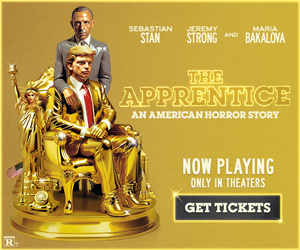
A Lot Like Love has opened and people know what the shot is, so here’s my question. The movie takes place over a seven-year span during which Ashton Kutcher and Amanda Peet meet and clack against each other like billiard balls and bounce around and don’t get down to really being with (and for) each other until the end, which is naturally presumed to be now, i.e., sometime in ’05. The story begins, therefore, sometime in ’98. Much of A Lot Like Love happens in New York City, and one of Peet and Kutcher’s early scenes happens somewhere in the vicinity of the East River and the Brooklyn Bridge, and at night. Now, what visual image would immediately convey that this scene is in fact happening several years ago? Obviously, a shot of the World Trade Center towers, which could be easily CG’d into the Manhattan skyline. This wasn’t done, one assumes, due to some form of cowardice or trepidation. Director Nigel Cole (Calendar Girls) didn’t want to throw in a slight gulp-inducing visual cue into a vaguely escapist relationship comedy because he lacked the confidence, and was afraid a glimpse of the towers would somehow upset the vibe. Well, okay, it might have for a minute or two, but life is like that sometimes, and this doesn’t mean lovers don’t go right back to being in love and saying dopey things to each other five minutes later. This movie rests on the idea of Peet and Kutcher’s relationship beginning several years back, and if Cole wanted to avoid the issue I’m raising here he could have easily shot their outdoor Manhattan scenes in Grammercy Park or Yorkville or anywhere else besides the way-downtown area of Manhattan. I understand that comic farces can’t touch reality without shattering their chemistry, but A Lot Like Love pretends to be emotionally earnest and socially particular and down-to-earth. Not using the twin towers as a visual backdrop was, I feel, a profoundly chickenshit move on Cole’s (and Disney’s) part.
You might expect the idea of Michael Bay remaking Alfred Hitchcock’s 1963 The Birds, as reported on 4.26 by THR‘s Liza Foreman, to induce purist convulsions among people like myself. But taken as a whole (and I mean apart from the excellent bird-attack sequences and the “end of the world” scene in the Bodega Bay diner), The Birds has always been a flat and rather stodgy film, and it could use some jazzing up. No one expects an egoist like Michael Bay to do a Gus van Sant and try and visually recapture Hitch’s 42 year-old original, and it would be a total shocker if Bay were to ape Hitch’s discipline in very gradually building the suspense and intimations of the coming bird attacks. We all know he’s going to speed up the story (if he pays any attention at all to the Hitchcock film or the Daphne du Maurier short story it was partly based upon) and go right for the jugular and heap on the CGI and so on. But at least Bay won’t have the terminally glacial Tippi Hedren as his lead actress (watch the Birds DVD…her performance wasn’t that good to begin with, and it really doesn’t hold up by today’s standards). And unless he’s a total klutz, Bay will have to be better with child actors that Hitch was. With the exception of the young Vernonica Cartwright’s, every kid performance in The Birds is flat-out awful…squirm-inducing. My son and I were watching the DVD a couple of months ago, and we were laughing and hooting when those black crows attack the kids as they’re running from the schoolhouse. Their acting was so bad that we wanted them to die.
Arianna Huffington’s celebrity-fed political blog, to be called
www.huffingtonpost.com, debuts on Monday, May 9th…the week the Cannes Film Festival begins. And Andrew Breitbart, the former Drudge Report webmaster, is finally copping to officially being on the team. Among those expected to supply (mostly leftish) rants and musings are Norman Mailer, David Mamet, Walter Cronkite, Vernon E. Jordan Jr., Maggie Gyllenhaal, Nora Ephron, Diane Keaton, etc. I’ve gotta say right off the top the site doesn’t sound like it’ll be quite smirky enough. I’d like to see more 40-and-under smarties like Ben Affleck, Owen Wilson, Ben Stiller, Jay Mohr, Neil Labute, etc. GenX appeal-wise, one wise-ass Jay Mohr piece will be worth 20 by Diane Keaton or Vernon Jordan. Don’t make this too much of a boomer thing or the wired generation will wave it off.

Heads Will Roll
The stand-out thing about The Ax, the new Costa-Gavras satire that opened the San Francisco Film Festival on Thursday night (4.23), isn’t that it’s utterly black. That’s obvious and easily digestible from the get-go. We’re used to this, in any case.
The money element for me — the selling point — is that it’s so bracingly dry. And tightly plotted and suspenseful. And the fact that it never quite tips into being a reassuring “comedy.”
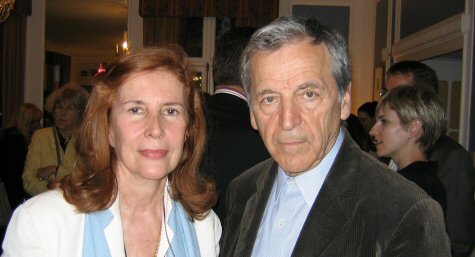
The Ax director and co-writer Costa-Gavras, producer (and wife) Michele Ray-Gavras during reception at home of Frederic Desagneaux — Friday, 4.22.05, 7:10 pm.
That in itself means a lot of people are going to find it a little too cool for their liking. This would be short-sighted of them, of course, because what Costa-Gavras has accomplished here is a very impressive balancing act.
The lead character, a kind of cold-blooded killer, could have been repulsive or at least alienating if the director’s mood and attitude had been off just an inch or two off. The Ax is lightly, ironically, mordantly humorous…and at the same time needling and nerve-wracking.
< ?php include ('/home/hollyw9/public_html/wired'); ?>
If you’ve seen The Corporation (which recently came out on DVD in a great two-disc package), you know the bedrock theme is that corporations are psychopathic. The Ax, which is taken from a 1997 Donald Westlake novel, flips this over and asks, what if a guy in a tough financial spot acted with the same win-at-all-costs, social-mores-be-damned attitude of a typical corporation?
What if an out-of-work guy, in other words, decided to increase his chances of finding a new job by killing the guys who appear to be his chief competitors?
Bruno Davert (Jose Garcia), 41, is a former top-level executive at a French paper mill who’s been fired (along with several hundred others) because the company decided to go with cheaper labor in another country. He hasn’t found a new job in over two and a half years, but he’s got his eye on a position at a big paper company called Arcadia.

The only thing (or things) standing in his way, he figures, are six or seven unemployed guys whose qualifications are as good if not better than his own. So he decides one day to eliminate them. He turns out to be a sloppy hit man, but he’s persistent and gets the job done.
Then the cops come knocking because they’ve noticed that a string of murders all involve male victims who worked for paper companies. And then the screws tighten further.
The twists and turns that follow make it a natural thing to root for Bruno, despite his constant murdering. There are few things in a drama as unnerving or even surreal as a truly sympathetic fiend. The Ax isn’t exactly “realistic” — the slightly arch and aloof tone underlines this — but it’s real enough to sink in and feel like something that’s part of our world.
Costa-Gavras seems to be saying to his audience, “Go a little easy on this guy. He may be killing one innocent victim after another, but he can’t find work and he’s really hurting and so he’s not really that bad. In fact, he’s almost blameless. If you want to blame someone, blame the corporations…blame globalism.”
The final irony of this film is that Bruno, his story and the underlying morale are not extreme elements. Every character, everything that happens is presented in moderate terms.
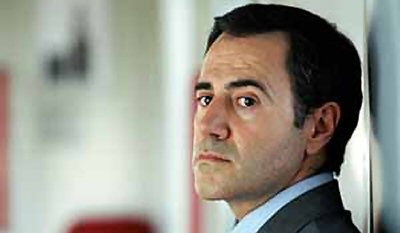
Bruno is a basically moral, considerate, middle-class family man who has been pushed into a state of almost animal-like ferocity. And yet he crosses the line as discreetly as he can manage, and then he is the recipient of incredible luck, and things finally work out. It’s all very neat and tidy.
The more I think about The Ax, the more I’m convinced it’s Costa Gavras’ best film — the most focused and most satisfying — since Missing (’82).
I respected his last film, Amen, which was based on The Deputy, a play about Vatican immorality during World War II, but I wasn’t blown away by it.
The Ax is certainly more assured than Mad City , Costa-Gavras’s 1997 film that was also about an average guy (John Travolta) pushed to desperate acts after losing his job.
The Ax joins a group of films that have come out over the last two or three years about the effects of corporate-think upon average middle-class people.
The most respected of these among elite film critics is Laurent Cantet’s Time Out, about a middle-aged husband and father who embarks on a massive charade in order to hide from his family the fact that he’s been laid off.
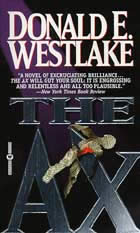
I’m not a huge fan of this film, personally. I respected it but I vaguely hated it. I felt drained by the passively dull and pig-eyed main character and the oppressive lethargy that seemed to seep out of the film at every turn.
There was also Cantet’s Human Resources, which portrayed the scruples of a young white-collar comer who finally decides to reject the rules of the game.
My favorite so far has been Jean-Marc Moutout’s Violence des Echanges en Milieu Tempere, which I saw at the Locarno Film Festival in the summer of `03. The title roughly translates into Violent Changes In The Workplace, although the English title is Work Hard, Play Hard. It was never distributed in the U.S. or even, as far as I know, put out on DVD.
I wrote back then that “as a portrait of what it means to be an agent of icy efficiency in a heartless business scheme, it’s one of the most riveting and quietly unsettling moral tales I’ve seen in a long while.”
Streets of San Francisco
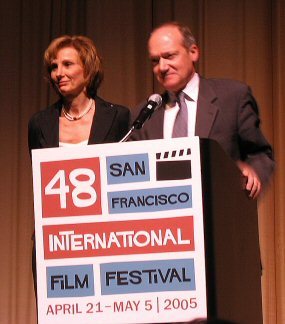
San Francisco Film Festival Executive Director Roxanne Messina Captor receiving a Chevalier Order of Arts and Letters medallion from French Consul General Frederic Desagneaux — Kabuki Theatre, 4.22.05, 8:12 pm.
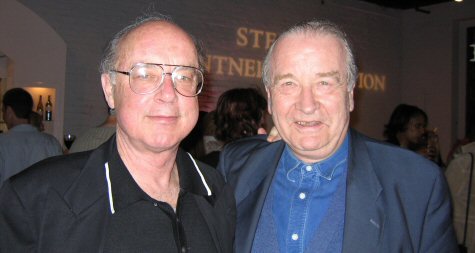
San Francisco Film Festival programmer and Telluride Film Festival kingmaker Tom Luddy (l.) and the festival’s French cinema programmer Michel Ciment at an outdoor opening night party for 48th annual San Francisco Film Festival at Girhardelli Square.

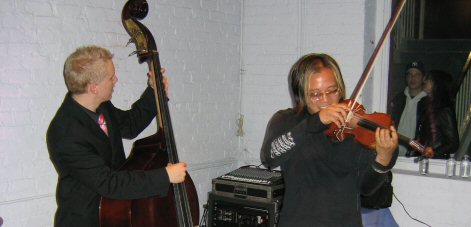
The great Bobby Yang on violin during a performance of a four-piece quasi-jazz group at VIP lounge at Ghirardelli Square.
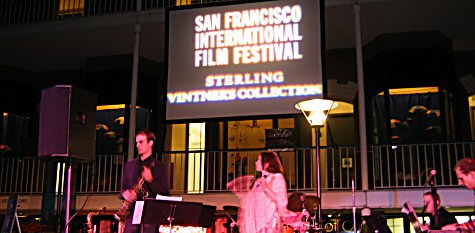
A jazz-lite group performs during Thursday night’s outdoor opening-nighter at Ghirardelli Square.

In north-facing living room of the home of Frederic Desagneaux, French Consul General of France, during 4.22 reception, at 7:20 pm.
Fine Madness
It’s out about eight months too late but there’s no sense crying over spilt milk and it doesn’t really matter anyway, because Nicholas Jarecki’s The Outsider is a surprisingly strong film.
It doesn’t simply capture the essence of director-writer James Toback in all the right ways (smartly, perceptively, humorously), and I don’t mean to imply that doing this alone would be some kind of marginal accomplishment.
I know Toback personally, and can say with some authority that Jarecki gets all the right quotes and insights and whatnot, and determines the measure of one of the nerviest and most relentless uber-mavericks in the film business today.
I’ve said several times in this column over the last five or six years that I admire Toback for his wit and smarts and maverick spirit. I’m especially taken by his moxie and tenacity in making his films his own way.
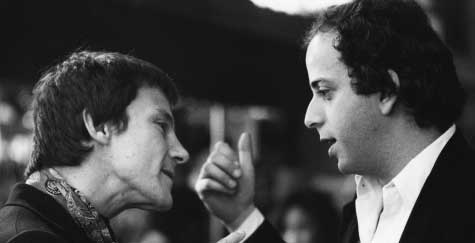
Harvey Keitel, James Toback during shooting of Fingers some 27 or 28 years ago.
And with one exception, I really like his movies. I loved Two Girls and a Guy and Black and White. I was even okay with most of Harvard Man. The irony is that the one Toback film I’m not terribly keen on is When Will I Be Loved?, the making of which is the focus of Jarecki’s doc.
But even a second- or third-tier Toback film is worth seeing, I feel, because of the aliveness of the personality behind it. Go to Jarecki’s site for The Outsider and listen to Toback’s comments during a radio interview with Joe Franklin, and you’ll have a clue about what I mean.
The Outsider is showing this evening (Saturday, 4.23) as an attraction of the Tribeca Film Festival at the Regal Battery Park, at 8:30 pm. It’s also showing at the Pace Schimmel Center on Friday, 4.29, at 9 pm, and on Sunday, May 1st, at the Regal Battery Bark at 1:15 pm.
Toback made When Will I Be Loved? because his producer, Ron Rothholz, found a financier who would put up a few million to make a film for tax reasons, but Toback would have to shoot the whole thing in about three weeks’ time, and with almost no time to prepare.
A Manhattan-based relationship drama shot in a semi-improvised fashion similar to his Black and White, When Will I Be Loved? is a somewhat cynical, more-than-frankly-sexual drama that stars Neve Campbell, Fred Weller and Dominic Chianese.

(l.) The Outsider director Nick Jarecki, When Will I Be Loved? costar Neve Campbell at reception; (r.) Jarecki and Harvey Keitel.
It’s hard to make a really exceptional film, much less a good one, in three weeks’ time, especially if you’re working from a script that has only been generally blocked out and needs to be somewhat improvised, as was the case here. It says a lot for Toback’s fast footwork that When Will I Be Loved? turned out as well as it did.
In the view of Roger Ebert, Christian Science Monitor critic David Sterritt, Newsday‘s Gene Seymour and other front-line critics, it was more than a pretty good effort. But Toback and Rothholz had a seriously rough time finding a distributor, and for a while there it looked like it might have to go straight-to-video.
What gives Jarecki’s doc that extra dimension is watching Toback face resistance from distributors and perhaps (and I’m basically talking impressions here) start to wonder deep down about whether he’s played it right this time. There’s something about seeing a guy who’s usually very confident and even a bit of a boaster and a swaggerer go through anger, denial, bargaining, additional shooting, etc.
The irony is that When Will I Be Loved?, which was finally acquired by IFC Films, performed decently where it played, and the DVD has brought in about $5 million so far, which isn’t nothing.
I spoke to Jarecki a few days ago. He called himself “the new Leni Reifenstahl,” and I leave readers to interpret that one all on their own.
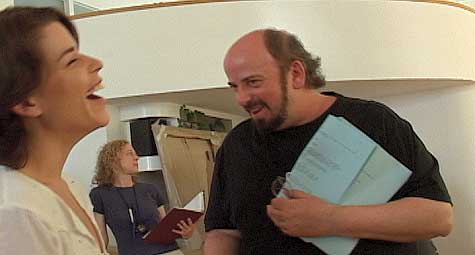
Neve Campbell (l.) and Toback on the set of When Will I Be Loved?.
He concurs that The Outsider‘s final act, in which Toback suffers his moments of doubt and pain, lend an extra dimension.
“The reality is that you make a crazy movie that doesn’t play by the rules and everybody says what the fuck is this? The reality is that he got hurt by the response to it. Jim makes his films up…and his personality in general is partially an example of how you have to be in the movie business, because he builds up a tremendous defensive wall.”
The talking-head admirers in The Outsider include Woody Allen, Robert Downey, Jr., Harvey Keitel, Mike Tyson, Neve Campbell, Norman Mailer, Brooke Shields, Barry Levinson, Robert Towne, Brett Ratner, Roger Ebert, Damon Dash, Woody Harrelson, Jim Brown, John Calley, Bijou Phillips, Jeff Berg, Dominic Chianese, and Power from Wu-Tang Clan.
We’ve all read George Bernard Shaw’s quote about how “reasonable men always try to adapt themselves to fit the world around them, while unreasonable men persist in trying to adapt the world to fit themselves, and therefore all progress is made by unreasonable men.” Or words to that effect. Take the point or not.
Doesn’t Matter
I don’t think it matters that much if some of the big-name critics are taking shots at Sydney Pollack’s The Interpreter (Universal, opened 4.22). All that counts is whether it’s been smartly promoted and, more to the point, whether or not there’s an appetite out there for this level of sophistication.
But it’s a curious thing to see a film you absolutely know to be a smart, above-average thriller be hammered and picked apart by people who know the difference between crap and good-enough quality, and who seem to have a stick up their ass.
You may not come out of this movie weeping or needing a double Jack Daniels to calm your nerves, but you’d have to have a pissy attitude not to admit that it’s a totally assured,bump-free ride. Smooth and crafty and well-ordered, and no trouble to sit through at all.
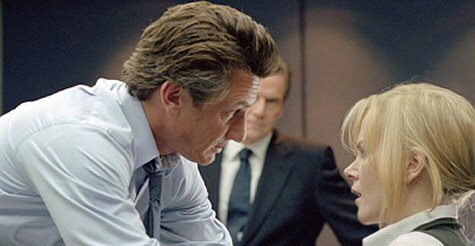
Sean Penn, Nicole Kidman in Sydney Pollack’s The Interpreter.
That sounds like damnation with faint praise. What I mean is, The Interpreter is a finely tuned engine. It’s a Bentley. Once it kicks in there’s no shifting in your seat or looking at your watch.
I’m a little perplexed by Eleanor Ringel Gillespie’s review in Friday’s (4.22) Atlanta Constitution. She calls it classy, well-honed, deftly organized…and then out comes the knife.
“As sleek and solid as a late ’50s Cadillac, The Interpreter is very much your father’s — perhaps, your grandfather’s — thriller,” she writes. “And that’s a good thing.”
Gillespie means that the kind of careful, exacting craft that Pollack put into making this film is a dying discipline. But she also knows that the notion of any movie being seen as appealing to fathers and grandfathers terrifies studio executives, agents, producers. She couldn’t have wounded Pollack more if she had literally stabbed him.
The Seattle Post Intelligencer‘s William Arnold is another wounding admirer: “Made with the intelligence, glossy production values and classic filmmaking technique that characterizes Pollack at his finest,” he calls The Interpreter “an elegant entertainment of the old school.”
Obviously there’s a consensus of opinion here. I even heard the term “old school” (or “old-fashioned”) from a guy who worked on the film, so I guess I’m in denial.
I suppose there are things in The Interpreter that feel a bit shop-worn. I just hate equating good craftmanship with “old-school.” Jesus, think of the implications.
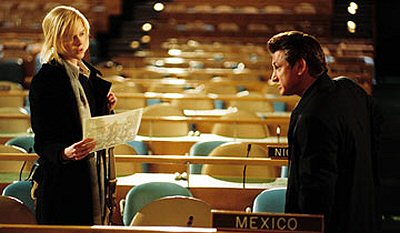
Are they saying it moves too slow? They’re nuts. William Steinkamp’s cutting is about as brisk and economical in the service of this kind of complex story as anyone can expect, and it’s faster and punchier than the cutting Pollack used for his last New York thriller, Three Days of the Condor, which came out in ’75.
In all the important ways, The Interpreter strikes me as fully caught up in the here and now. It just doesn’t have that visual-energy-for-visual-energy’s-sake thing that a lot of 40-and-under directors love to put in their films. And the naysayers are telling me that’s a bad thing?
Is it really such a rickety, old-fashioned pleasure to enjoy careful strategic weaving of dozens of story strands that have to fit together just so and pay off in just the right way?
Are we saying that thrillers that don’t necessarily add up or which try to wallop their way past difficult plot points are the kind of films that younger paying audiences prefer?
I give up. I’m talked out on this film. The duel is over. It’s in the public’s hands now.
Saturday figures suggest The Interpreter will earn in the vicinity of $20 to $22 million this weekend. Not bad. Something tells me the hold factor won’t be all that great next weekend, but let’s keep our cynicism in check.
DVD Commentaries
I’ll be popping in some of the letters I got about this subject on Sunday morning. I don’t know why it’s taking me so long to put this column up, but I feel like I’m covered in gelatin and stuck in some kind of eerie slow-mo realm.
Absent Ace
“I recently came across the fantastic Billy Wilder film Ace in the Hole (re-released as The Big Carnival). Unfortunately, it’s only available on a rare VHS copy (I found it at Vidiots in Santa Monica) and the dialogue is out of sync for most of the film.
“You often use your column to promote films deserving of the deluxe DVD treatment and I think this one more than qualifies. This is a media satire, after all, that is possibly even more relevant today than when it was released.
“I was going to point to Elia Kazan and Budd Schulberg’s A Face in the Crowd as another example of both a great media satire and a film criminally overlooked on DVD, but Amazon now shows that a DVD version will be release on May 10.

“Just thought I’d bring that to your attention. Do with it what you will.” — Chris Casper , Los Angeles, CA.
Wells to Casper: I love Ace in the Hole and yes, of course, it should be digitally restored and released on DVD. It’s not that bitter by today’s standards, although it was seen as overly so in 1951 when it was first released.
I’ve always loved Ace in the Hole‘s dialogue, which came from Wilder, Walter Newman and Lesser Samuels.
I adore that rant from Douglas’ newspaper reporter character about how he prefers those “four spindly trees” in front of Rockefeller Center over the vast wonders of nature commonly found in Hicksville because he can’t stand the hicks.
Jan Sterling to Douglas after an abusive verbal smack-down: “I’ve known some hard-boiled eggs in my time, but you’re twenty minutes.”

Room #501, Rex Hotel, 562 Sutter Street, San Francisco.

Schmoozers at Castro theatre prior to opening-night showing of the new Costa-Gavras film, The Ax (i.e., Le Couperet).
In a current USA Today story, reporter Anthony Breznican asks whether or not Ridley Scott’s Kingdom of Heaven (2oth Century Fox, 5.6) will save the big-budget historical epic genre. Breznican’s piece suggests that since the expensive battle flicks Troy, Alexander, King Arthur and The Alamo were “all casualties of middling U.S. ticket sales,” that a similar fate may await Scott’s $130 million film about the Crusades. Scott replies that a film’s emotional content is more important than spectacle or battles, and that this is provides in the relationship between Kingdom‘s Orlando Bloom and Eva Green. I’m personally more in agreement with Kingdom screenwriter William Monahan’s view that “the problem’s not epics… there’s a problem with people who don’t know how to do epics properly. If you’re not filling seats at a showing of an adequately advertised motion picture, the audience hasn’t failed you…you’ve failed the audience.” All the billboard ads and TV spots for Kingdom indicate a vigorous attempt to promote it, but I’m told there’s been some disappointment among Fox marketers that the film isn’t tracking better. It would be a shame if this film didn’t perform, because by my standards it’s really got the goods.
I’ve been told that Monster in Law (New Line, 5.13), the Jane Fonda vs. Jennifer Lopez marital comedy, is a hit. The numbers are said to be good (in the mid ’80s or thereabouts), the script works, and apparently the benefit is more J. Fo’s than J. Lo’s. (“Lopez is good but Fonda is terrific,” is how it was put to me.) I don’t know what the dollar projection would be, but I’m hearing it’s definitely some kind of cash cow. An even bigger hit for New Line is David Dobkin’s The Wedding Crashers, the Owen Wilson-Vince Caughan comedy that opens on 7.15. The numbers for this one are through the roof (higher than Monster-in-Law‘s, which probably means somewhere in the ’90s), which seems to indicate a likely haul of $100 million or higher. And there may be a third New Line winner in the Tony Scott actioner Domino (8.19), which I’ve been hearing promising things about since last December. (Richard Kelly’s script is the shit.) If there’s research on this one, it hasn’t been shared.

Beautiful Journey
How many coming-to-America immigrant movies have I seen that have put the hook in? Not that many. Up until two days ago I would have said I’m not a huge fan of this genre, if you can call it that. People uprooted, struggling, adversity, etc. I’ve got enough aggravation.
I remember liking Elia Kazan’s America, America (1963), about a young Greek guy (based upon Kazan’s uncle) making his way to these shores. And the young Vito Corleone, Robert De Niro, life-in-Little- Italy sections of The Godfather, Part II. And I’ll never forget Oliver Stone’s Heaven and Earth (1993), about a young Vietnamese woman going through all kinds of pain on her way to the States. It was hell to sit through, I mean.

Damien Nguyen, Thi Kim Xuan Chau, Bai Ling aboard freighter in Hans Petter Moland’s The Beautiful Country.
And that was pretty much it for me until last Monday night, when I saw Hans Petter Moland’s The Beautiful Country (Sony Pictures Classics, 7.8) and just about flipped.
It won’t open for another two and a half months, which is plenty of time for people to read this article and then forget about it, but this 125 minute Norwegian-made, mostly English-speaking film is, by my sights, a nearly great thing. And it’s come out of nowhere, in a sense. And it needs all the advance word it can get.
< ?php include ('/home/hollyw9/public_html/wired'); ?>
A road (and sea) movie in the most profound sense of that term, and a story about the resilience of the human spirit (although I have mixed feelings about describing it this way, given how totally full-of-shit that last proclamation sounds), The Beautiful Country is a movie about restraint, restraint and more restraint…and eventually, huge payoffs.
Especially during the last 20 minutes or so, when the great Nick Nolte arrives.
Set in 1990, The Beautiful Country is about a mixed-race, half-American young Vietnamese guy named Binh (Damien Nguyen) whom we first meet in a rural Vietnamese village working as a handy man, and dealing with racist disdain for being the son of an American G.I., and generally wondering who he is and where he belongs.
The movie follows Binh to Saigon (Ho Chi Minh City) to find his long-lost mother. He lives and works with her for a spell, and then something bad happens and he drifts off to sea with some boat people with his mother’s young son in tow.
They land in a Malaysian refugee camp, where Binh meets and falls in love with the beautiful Ling (Bai Ling). He and Ling and the boy eventually climb aboard a rusty freighter, which is captained by a cold-hearted prick (Tim Roth), that’s transporting illegals to the U.S.

And then it’s into his life in New York City as an indentured slave worker in a Chinatown restaurant, and finally a trip to Texas where he eventually finds his dad, who turns out to be Nolte.
The 64 year-old Nolte gives one of best-ever performances, and if you ask me is a probable candidate for a Best Supporting Actor nomination eight or nine months from now.
I could feel The Beautiful Country taking hold and feeling like the real deal almost immediately. You can say it’s not 100% perfect (maybe a tad cliched here and there, but only a little bit), and that it’s just another variation on a Terrence Malick-styled young-people-on-the-run movie. (Malick thought up the basic story idea and co-produced the film with Badlands producer Edward Pressman).
But it felt to me (and I can be a soft touch at times) like some kind of masterwork…one of the most profound and compassionate and finely nuanced films about the rough-and-tumble, never-say-die life of a roaming, disenfranchised person I’ve ever seen.
It’s also a great Vietnam healing movie for American audiences. I don’t know how to put it exactly, but this film feels like it’s in touch with feelings about the Vietnam War that should have come to the surface a long time ago. It’s a movie that says to American vets and Vietnamese nationals, “Uhm, guys? You need to talk.” It seems to be mining the emotional aftermath of this 40 year-old conflict on a level that’s never really been sorted out before. And without raising this or that issue or memory or specific incident. It all just kind of seeps in.

Beautiful Country director Hans Petter Molan with star Damien Nguyen.
It’s also a great and sometimes very sad movie about parenting. And it ends with a father-son moment that really touches bottom. And it manages to make the title of the film echo back in a way that feels different and thoughtful.
The irony is that The Beautiful Country was half-written off, or at least put on hold in the minds of potential distributors, after it was shown at the Berlin Film Festival in February 2004. It ran 136 minutes, and everyone (or a good percentage of those who were there) thought it was too long.
It took Moland, Malick and Pressman several months to prune it down to 125 minutes, partly over creative disagreements, and partly, I’ve been told, due to post-production coin being a little short. It played at Karlovy Vary last summer, but the trimmed version, I’ve heard, wasn’t completed in time to make the deadline for last September’s Telluride and Toronto and New York Film Festivals. And it didn’t play Sundance.
But the guys at Sony Pictures Classics saw through all this and now it’s slated as a mid-summer counter-programmer.
The people who mainly go to dumb-shit movies and don’t want to know or feel anything new or exotic will probably figure out ways of ducking The Beautiful Country, and maybe not even seeing it on DVD. It’s their loss and what can you do?
I didn’t know Moland at all before this, but he knows exactly what he’s doing here. I’m told I should see a mother-daughter relationship film he directed in 2000 called Abderdeen.

The Beautiful Country screenplay is by Sabina Murray and Larry Gross, working from a “story” by Lingard Jervey and an idea by Malick.
I said earlier that Roth’s character is a prick, and he is, but it’s part of this film’s delicate calibrations that he’s not painted too broadly and has other colors to show. There’s an American businessman who takes an interest in Ling in the New York section who could have been portrayed as a crass vulgar sort, but he, too, comes through with a certain humanity. Ditto the middle-aged woman who plays Nolte’s angry ex-wife.
There are one or two exceptions, but just about everyone in this movie has some kind of unexpected (by the cut-and-dried standards of too many films these days) dimension.
Stuart Dryburgh’s widescreen photography reminded me at times of the work of Chris Doyle (the dp for all those Wong Kar Wai films as well as Phillip Noyce’s The Quiet American ), which came as something of a surprise. Dryburgh is a respected veteran and all, but his recent credits (Aeon Flux, Bridget Jones’ Diary, Runaway Bride, Analyze This) don’t exactly say “art film cinematographer.”
I disagree with those who’ve said that Nguyen’s performance, which is all about being quiet and saying very little and frequently cowering, is some kind of liability. I believed in his character completely, and didn’t detect a single false note. I actually found him charismatic in a tentative, meditative, internalized way.
Bai Ling, a fairly well-known Asian actress who’s been working in Hollywood for about ten years (Red Corner, Anna and the King, Star Wars, Episode 3: Revenge of the Sith), seems out of place in the Malaysian refugee camp…at first.

Nick Nolte, Damien Nguyen.
She seems too shrewd and attractive to be from the bottom rung, or to have landed in such dire straits. But I bought into this because she delivers a convincingly cynical (bordering on bitter) attitude, and because I wanted her character to hook up with Binh.
Some critics (I can almost predict which ones) won’t fall for this film like I have, and that’s fine. But I can’t imagine anyone not being wowed by Nolte, who gathers that whole grizzled-older-guy thing that he’s been developing over the past 10 years or so and knocks it out of the park.
The title, according to Derek Elley’s Variety review, refers to the Chinese name for America — “mei guo” — which literally means “beautiful country.” But this is a film about beauty in all corners of the world, and in all sorts of unexpected places.
I realize this makes me sound like Sydney Skolsky, but I’m hearing excellent things about March of the Penguins, a French film said to have drop-dead beautiful photography. The director-cowriter is a guy named Luc Jacquet, and it’s about a flock of emperor penguins on their annual trek across Antarctic and all the classic life rituals and survival challenges they go through. A critic friend who’s seen it says this Warner Independent release “will do for those tuxedoed Antarctic dwellers what Winged Migration did for birds in flight.” The version that’s been screened so far has the original schlocky French soundtrack (my friend says parts of it “sound like Bjork gone Muzak, along with character voices for Mommy, Daddy and Baby penguin”), which is being trashed. Hipper sounds are being put in its place along with “a natural-science narration.” (I’m not supposed to reveal the name of the big-name actor who will read it). Pic will open on 6.24.05 in New York, L.A., San Francisco, Boston, Chicago and D.C., and expand in mid-July.
Deserving of special attention at next month’s Cannes Film Festival, I’m hearing, will be James Marsh’s The King, which stars an English-speaking Gael Garcia Bernal as a discharged Navy guy who comes home to Corpus Christi, Texas, and resolves some long-buried family issues. Marsh co-authored the screenplay with Milo Addica (Birth, Monster’s Ball), whose work I’ve come to admire. The film will be one of the Un Certain Regard attractions. William Hurt, Laura Harring, Paul Dano and Pell James costar. Marsh’s last feature was the startling Wisconsin Death Trip (1999).

 Really Nice Ride
Really Nice RideTo my great surprise and delight, Christy Hall‘s Daddio, which I was remiss in not seeing during last year’s Telluride...
More »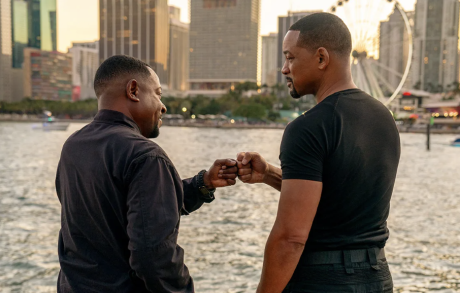 Live-Blogging “Bad Boys: Ride or Die”
Live-Blogging “Bad Boys: Ride or Die”7:45 pm: Okay, the initial light-hearted section (repartee, wedding, hospital, afterlife Joey Pants, healthy diet) was enjoyable, but Jesus, when...
More »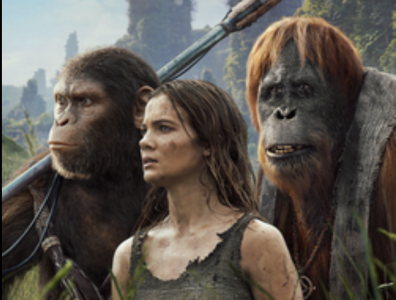 One of the Better Apes Franchise Flicks
One of the Better Apes Franchise FlicksIt took me a full month to see Wes Ball and Josh Friedman‘s Kingdom of the Planet of the Apes...
More »
- The Pull of Exceptional History
The Kamala surge is, I believe, mainly about two things — (a) people feeling lit up or joyful about being...
More » 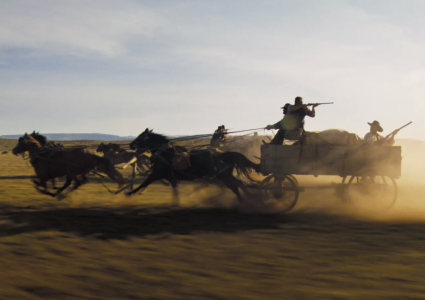 If I Was Costner, I’d Probably Throw In The Towel
If I Was Costner, I’d Probably Throw In The TowelUnless Part Two of Kevin Costner‘s Horizon (Warner Bros., 8.16) somehow improves upon the sluggish initial installment and delivers something...
More » Delicious, Demonic Otto Gross
Delicious, Demonic Otto GrossFor me, A Dangerous Method (2011) is David Cronenberg‘s tastiest and wickedest film — intense, sexually upfront and occasionally arousing...
More »


